For a few weeks in June 2013 I was in the Auvergne (France) for a holiday with my family. Of course I tried to spot some dragonflies. The first days I saw only a lot of Large Red Damselflies (Pyrrhosoma nymphula). This is an early species and it looked like spring just started in the Auvergne. The females here look a bit different from the ones I know from the Netherlands. More yellow, less red.
What I was hoping for however were lots of Beautiful Demoiselle (Calopteryx virgo). The location looked perfect: cool flowing water in a stream with trees around. But nothing to see. After a week, I spotted one single individual.
Luckily that one turned out to be first of many. During the next days there were dozens of them. All had brown wings, even the males. Males are supposed to have blue wings, but young males appear to have brown wings, just like females.
For the rest, I did not see many odonata species. A couple of Broad-bodied Chasers (Libellula depressa) and, near an artificial lake two Red-veined Darters (Sympetrum fonscolombii). That was it. Just a little bit disappointing.
Wednesday, July 3, 2013
Saturday, May 7, 2011
Ruby Whiteface by the dozens
Only once before I had seen more then a dozen of the Ruby Whiteface (Leucorrhinia rubicunda), but this time it was better. A better location for sure (Engbertsdijksvenen in the Netherlands close to the border with Germany). A better time maybe. It was the same time of year, late in April, but the last years have shown warm springs and this year was especially warm. That might have given the dragonfly species of Spring an advantage.
Anyway. While walking through the area I felt I had to stop every 50 or 100 meters to watch another concentration of the Ruby Whiteface. And every time I counted dozens of them. A very nice detail was that the area provided a nice background for photographing them. Previously I could only photograph them while sitting on a dark ground, and because this species is mostly black, the photos did not come out well. Better this time.
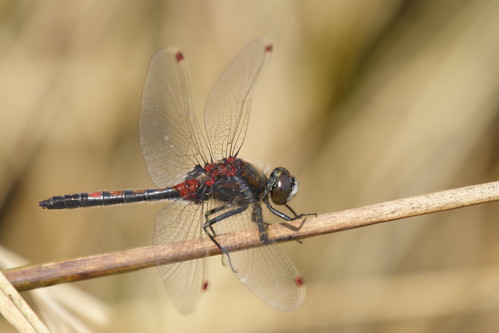
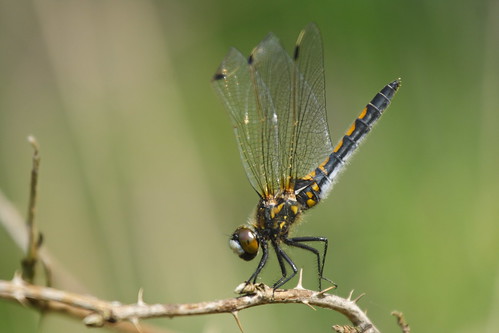
At one location there were plenty of copula's and I caught a female laying eggs, while the male was holding guard in the air near her.
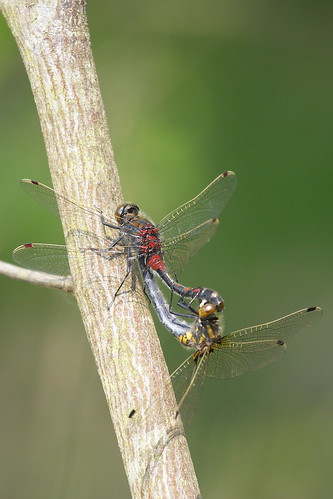
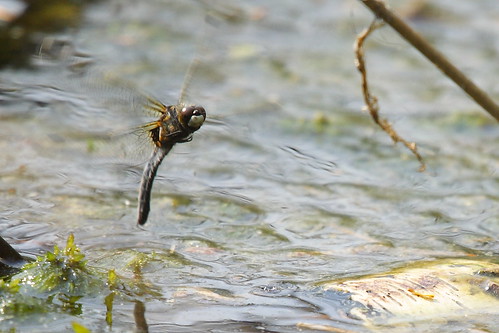
To be honest, seeing dozens of the Ruby Whiteface on one location isn't very special. Other people have reported hundreds of them. An interesting photo is here, showing a tree full of them.
Anyway. While walking through the area I felt I had to stop every 50 or 100 meters to watch another concentration of the Ruby Whiteface. And every time I counted dozens of them. A very nice detail was that the area provided a nice background for photographing them. Previously I could only photograph them while sitting on a dark ground, and because this species is mostly black, the photos did not come out well. Better this time.


At one location there were plenty of copula's and I caught a female laying eggs, while the male was holding guard in the air near her.


To be honest, seeing dozens of the Ruby Whiteface on one location isn't very special. Other people have reported hundreds of them. An interesting photo is here, showing a tree full of them.
Tuesday, July 28, 2009
Aeshna isoceles likes flowers of the Water Soldier
The English name is Norfolk Hawker, because in the UK the species can only be found in Norfolk. The name Green-eyed Hawker had been proposed, and that makes more sense, because the species is present in many countries outside of the UK. Aeshna isoceles is particularly common around where I live. I have spotted it several times even in city parks. But I had never seen this species ovipositing before.
Is it rare to spot oviposition of Aeshna isoceles? I did a quick check on waarneming.nl. For the Norfolk Hawker less than 1% of the observations was oviposition, as compared with more than 2% for Aeshna grandis and more than 5% for Anax imperator. So maybe it isn't very rare, but it seems to be less common.
This time I was lucky. It was at the beginning of the evening, around 18:45. Maybe the evening is a good time for oviposition, because the males are less active and so less likely to disturb the ovipositing females.
But anyway, I was there, and she was there. She picked a place for oviposition that was only 20 centimeters or so from the water side, allowing me to make this photo.
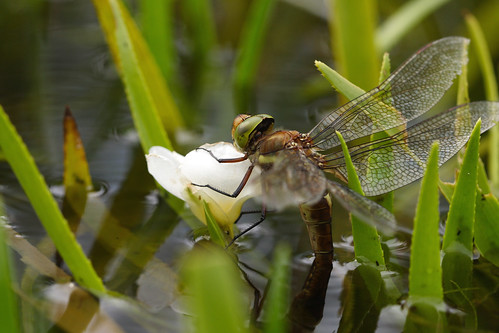
The most interesting part however is still to come. While I was watching this female fly around, I noticed that she was particularly interested in the flowers of the Water Soldier (Stratiotes aloides). Not the leaves, but the flowers. She was flying from flower to flower. One of the was unreachable for her, because the leaves around it left not enough space for her wings. She tried, but could not get to it. As can be seen on the photo, the flower is where she wanted to lay her eggs.
Of course this is just a single observation. I did a search on internet and found that the wikipedia article on the Norfolk Hawker shows photos of ovipostion on Water Soldier leaves. Another photo elsewhere (here) showed oviposition on a flower. And on a forum somebody said that oviposition of Aeshna isoceles on the Water Soldier isn't always, but quite often on flowers.
By the way, it is good to know that Aeshna isoceles seems strictly dependent on Water Soldier in the UK, but not elsewhere. In the Netherlands it seems to prefer Water Soldier, but does not depend on it.
Is it rare to spot oviposition of Aeshna isoceles? I did a quick check on waarneming.nl. For the Norfolk Hawker less than 1% of the observations was oviposition, as compared with more than 2% for Aeshna grandis and more than 5% for Anax imperator. So maybe it isn't very rare, but it seems to be less common.
This time I was lucky. It was at the beginning of the evening, around 18:45. Maybe the evening is a good time for oviposition, because the males are less active and so less likely to disturb the ovipositing females.
But anyway, I was there, and she was there. She picked a place for oviposition that was only 20 centimeters or so from the water side, allowing me to make this photo.

The most interesting part however is still to come. While I was watching this female fly around, I noticed that she was particularly interested in the flowers of the Water Soldier (Stratiotes aloides). Not the leaves, but the flowers. She was flying from flower to flower. One of the was unreachable for her, because the leaves around it left not enough space for her wings. She tried, but could not get to it. As can be seen on the photo, the flower is where she wanted to lay her eggs.
Of course this is just a single observation. I did a search on internet and found that the wikipedia article on the Norfolk Hawker shows photos of ovipostion on Water Soldier leaves. Another photo elsewhere (here) showed oviposition on a flower. And on a forum somebody said that oviposition of Aeshna isoceles on the Water Soldier isn't always, but quite often on flowers.
By the way, it is good to know that Aeshna isoceles seems strictly dependent on Water Soldier in the UK, but not elsewhere. In the Netherlands it seems to prefer Water Soldier, but does not depend on it.
Friday, June 19, 2009
Collective odonata mapping on the web
There are a couple of sites on internet where people can add their odonata sightings on a map. That is quite interesting, because if enough people participate, it results in distribution maps of species.
It not easy to find such sites, even when they are big, but maybe I do not use the right search terms. Here is a list of sites which I know of. If you know more, please let me know (for example add a comment).
Personally I make use of a Dutch site at http://waarneming.nl. The code of this site is used in Belgium at http://waarnemingen.be, and even in a worldwide variant at http://observado.org. These sites are not only meant for dragonflies, but for basically all groups of organisms. It is most active for bird sightings.
 The generated maps in the worldwide variant includes the sightings from the Dutch and Belgian variants. The worldwide variant seems to be in use mainly by people from the Netherlands and Belgium, recording their sightings when on holiday. For odonata it generates maps like this (for Aeshna mixta). As you can see it makes use of Google Maps. See for the actual map on the site here. Evidently most sightings come from the Dutch and the Belgian database.
The generated maps in the worldwide variant includes the sightings from the Dutch and Belgian variants. The worldwide variant seems to be in use mainly by people from the Netherlands and Belgium, recording their sightings when on holiday. For odonata it generates maps like this (for Aeshna mixta). As you can see it makes use of Google Maps. See for the actual map on the site here. Evidently most sightings come from the Dutch and the Belgian database.
There is another Dutch site at http://www.telmee.nl. I am not sure how much these sites are in competition. What I read is that they do exchange entered sightings (if the observer agrees), but that the exchange process could be better.
All sites above are offered in different languages.
In Denmark there is http://www.fugleognatur.dk. My Danish isn't very good, and I do not see an option to change the language. To get to the dragonfly section, click the link Naturbasen and then in the dropdown with the text "Vælg artsgruppe", pick "Guldsmede" (which is the Danish word for dragonflies). That gives the recent sightings. The odonata species list is at Artslister -> Guldsmede. Each species has some information, including a map of the sightings.
In Germany I am aware of two sites: http://www.naturgucker.de (which does all organisms - including odonata - and has some European-wide pretentions) and there is a dragonfly mapping project at www.science4you.org, called Libellen Europas.
For Sweden there is a dragonfly mapping project at artportalen.se, with an odonata species list + map.
Then for North-America there is http://www.odonatacentral.org. Well, actually also this has world-wide pretentions, but the searching on the map for Aeshna mixta, currently shows just 2 records, both in the UK. But it seems that there are many records for North-American species.
I guess I should end with some conclusion or recommendation, but I have none. It is nice to see that things are working more or less. And of course one can dream of about a world-wide united database. But user-entered data also need to be checked. And nobody is going to check user-entered sightings on a world-wide scale. On a smaller scale, there are experts who know what to expect, which data are impossible or improbable. For that reason, a small-scale (national) approach seems necessary to me. And if the checked sightings in the different databases can be exchanged between national initiatives, that would be great.
It not easy to find such sites, even when they are big, but maybe I do not use the right search terms. Here is a list of sites which I know of. If you know more, please let me know (for example add a comment).
Personally I make use of a Dutch site at http://waarneming.nl. The code of this site is used in Belgium at http://waarnemingen.be, and even in a worldwide variant at http://observado.org. These sites are not only meant for dragonflies, but for basically all groups of organisms. It is most active for bird sightings.
 The generated maps in the worldwide variant includes the sightings from the Dutch and Belgian variants. The worldwide variant seems to be in use mainly by people from the Netherlands and Belgium, recording their sightings when on holiday. For odonata it generates maps like this (for Aeshna mixta). As you can see it makes use of Google Maps. See for the actual map on the site here. Evidently most sightings come from the Dutch and the Belgian database.
The generated maps in the worldwide variant includes the sightings from the Dutch and Belgian variants. The worldwide variant seems to be in use mainly by people from the Netherlands and Belgium, recording their sightings when on holiday. For odonata it generates maps like this (for Aeshna mixta). As you can see it makes use of Google Maps. See for the actual map on the site here. Evidently most sightings come from the Dutch and the Belgian database.There is another Dutch site at http://www.telmee.nl. I am not sure how much these sites are in competition. What I read is that they do exchange entered sightings (if the observer agrees), but that the exchange process could be better.
All sites above are offered in different languages.
In Denmark there is http://www.fugleognatur.dk. My Danish isn't very good, and I do not see an option to change the language. To get to the dragonfly section, click the link Naturbasen and then in the dropdown with the text "Vælg artsgruppe", pick "Guldsmede" (which is the Danish word for dragonflies). That gives the recent sightings. The odonata species list is at Artslister -> Guldsmede. Each species has some information, including a map of the sightings.
In Germany I am aware of two sites: http://www.naturgucker.de (which does all organisms - including odonata - and has some European-wide pretentions) and there is a dragonfly mapping project at www.science4you.org, called Libellen Europas.
For Sweden there is a dragonfly mapping project at artportalen.se, with an odonata species list + map.
Then for North-America there is http://www.odonatacentral.org. Well, actually also this has world-wide pretentions, but the searching on the map for Aeshna mixta, currently shows just 2 records, both in the UK. But it seems that there are many records for North-American species.
I guess I should end with some conclusion or recommendation, but I have none. It is nice to see that things are working more or less. And of course one can dream of about a world-wide united database. But user-entered data also need to be checked. And nobody is going to check user-entered sightings on a world-wide scale. On a smaller scale, there are experts who know what to expect, which data are impossible or improbable. For that reason, a small-scale (national) approach seems necessary to me. And if the checked sightings in the different databases can be exchanged between national initiatives, that would be great.
Sunday, May 31, 2009
Banded Demoiselles in the city of Utrecht

A few years ago (in 2006), during a small walk in my neighborhood, I saw a blue-winged damselfly sitting on a fence. And although I was not so much into odonata at the time, I knew what it was: a Banded Demoiselle (Calopteryx splendens). During the next days I bought a DSLR camera and in the following months I devoted much of my spare time at that small canal ("gracht" in Dutch), trying to photograph these Damselflies at the spot. There were many of them. Once I counted over 50 males.
And the end of the season I had many photos and organized a small exhibition at a local environmental centre, also to show the inhabitants at the canal what I had been doing in their area all year.
It surprised me most that these lived here in the middle of a city. I learned from the inhabitants there, that the Banded Demoiselles had been there at least for a couple of years. From other sources I learned that, after a vast decline, the Banded Demoiselle has been slowly progressing along the Kromme Rijn river since the 1980's, and that it had been spotted at several places in the city.
Since then I have been looking for odonata at other sites near (and sometimes in) Utrecht. But of course every year I also take a look at this city population of Banded Demoiselles. Untill now they are there every year, although not in such large numbers as in 2006. Usually I count maximally 10 or 20 individuals. And I still make some photos of them. Like the one below, which I made yesterday.
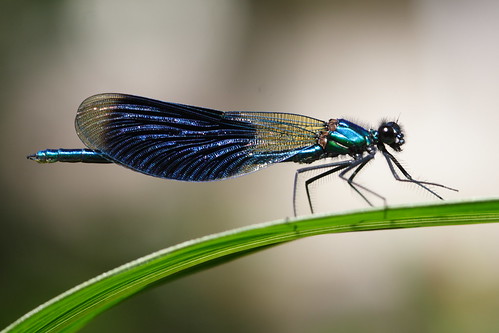
Saturday, January 10, 2009
Sympecma fusca, surviving in the winter
The Common Winter Damselfly (Sympecma fusca) hibernates as an adult. Yesterday I took the challenge to find some of them. It turns out that I am a lousy searcher. On the location which I suggested myself, some others went looking and found multiple individuals. One person exactly described the branch where one could be found. That is the only one I was able to find. But I made some nice photos.
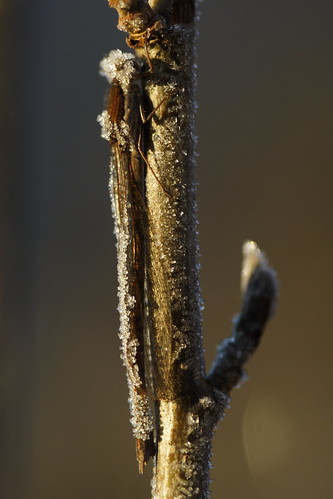
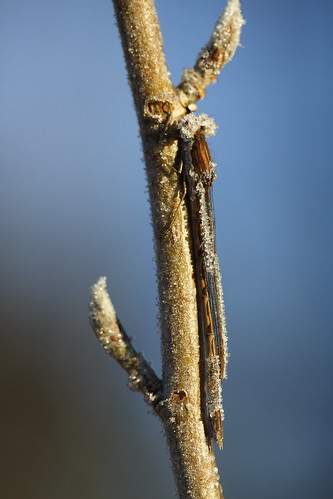


Wednesday, October 15, 2008
Late sightings of Erythromma najas
The Red-eyed Damselfly (Erythromma najas) is a species of early summer, adults are mainly seen in late May and June.

Sightings in other months are not uncommon. Last year (2007), on the Dutch site waarneming.nl sightings were reported from April 17. This year (2008) the first sighting was reported there on May 3.
But what about late sightings? Sightings in July and to a lesser extend August are not uncommon, although the number of sighted individuals declines. Personally I could report only a single imago in August this year and none in September. At the end of September somebody reported multiple individuals in an area quite close to where I have been watching dragonflies this year. Interesting information was that the number of individuals seemed to have slightly increased as compared with the previous weeks. These late Red-eyed Damselflies were not worn-out old individuals, they must have been emerged quite recently.
But even while paying extra attention to this species, "my" area looked still void of Red-eyed Damselflies. On October 11, I did some effort to get into the area of the reported sightings (it is private property and I don't want to enter that without permission). And yes, I was happy to spot one male. Although I did not succeed in taking a photo, it was exciting. But is it really that rare? Although most sites do not mention Erythromma najas as a species flying in October, British Insects (Watson, L., and Dallwitz, M.J.) says that "adults are on the wing from early May to early October.
It leaves us with some questions. It is not totally clear if this species has a one-year or two-year development cycle. Maybe it does not have a clearly defined seasonal cycle. The species is listed as a "trans-seasonal" species with an "asynchronous emergence" in some studies. I could not find a clear definition of these terms (so help me out if you can). So far I understand that although there is a clear seasonal peak, the species can get through the winter in different stages of development.
Also it seems that data from the UK show that in response to global warming, Erythromma najas is expanding its flight season in both directions: it is found both earlier and later in the season than in previous times. If global warming continues, we can probably expect more October sightings.
Links
Historical changes in the phenology of British Odonata are related to climate (PDF) Flight seasonality of dragonflies (insecta, odonata) in Northeastern Ukraine (PDF)

Sightings in other months are not uncommon. Last year (2007), on the Dutch site waarneming.nl sightings were reported from April 17. This year (2008) the first sighting was reported there on May 3.
But what about late sightings? Sightings in July and to a lesser extend August are not uncommon, although the number of sighted individuals declines. Personally I could report only a single imago in August this year and none in September. At the end of September somebody reported multiple individuals in an area quite close to where I have been watching dragonflies this year. Interesting information was that the number of individuals seemed to have slightly increased as compared with the previous weeks. These late Red-eyed Damselflies were not worn-out old individuals, they must have been emerged quite recently.
But even while paying extra attention to this species, "my" area looked still void of Red-eyed Damselflies. On October 11, I did some effort to get into the area of the reported sightings (it is private property and I don't want to enter that without permission). And yes, I was happy to spot one male. Although I did not succeed in taking a photo, it was exciting. But is it really that rare? Although most sites do not mention Erythromma najas as a species flying in October, British Insects (Watson, L., and Dallwitz, M.J.) says that "adults are on the wing from early May to early October.
It leaves us with some questions. It is not totally clear if this species has a one-year or two-year development cycle. Maybe it does not have a clearly defined seasonal cycle. The species is listed as a "trans-seasonal" species with an "asynchronous emergence" in some studies. I could not find a clear definition of these terms (so help me out if you can). So far I understand that although there is a clear seasonal peak, the species can get through the winter in different stages of development.
Also it seems that data from the UK show that in response to global warming, Erythromma najas is expanding its flight season in both directions: it is found both earlier and later in the season than in previous times. If global warming continues, we can probably expect more October sightings.
Links
Subscribe to:
Posts (Atom)


